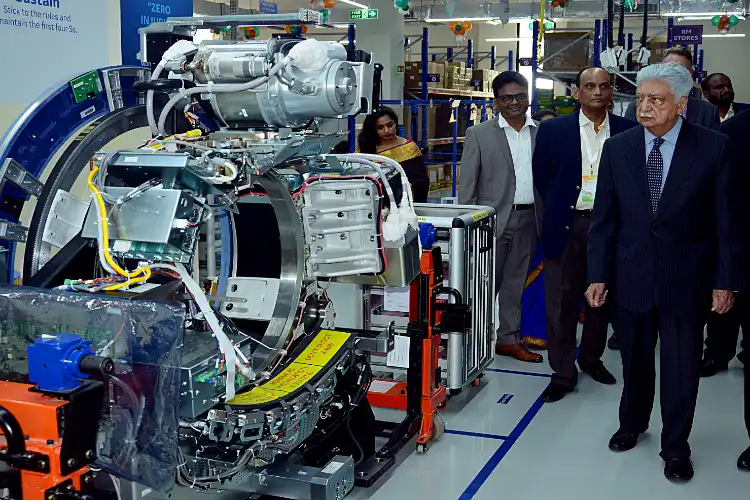
 Sushma Ramachandran
Sushma RamachandranAs the economy is reviving, any green shoots of recovery are welcome indicators of moving towards a higher growth path. The latest is the data now showing manufacturing has been growing at a robust pace during the first month of the current fiscal, April. This is despite inflationary pressures and the fall-out of the Ukraine conflict that has led to higher input and transport costs. The improved outlook has been reflected in the S&P Global India Manufacturing Purchasing Managers Index (PMI) for the month. It was 54.7 during April compared to 54 in March.
The PMI records positive growth if it is over 50 and a decline below this number. The private sector indicator is based on the results of a survey sent to a group of manufacturing companies.
The news comes just as concerns are growing over rising costs of a wide range of inputs as a result of the Ukraine conflict and movement curbs in China owing to Covid. Reports indicate that automobile and electronics manufacturers are getting set for a hike at prices over the next few months. Logistics issues are also plaguing producers as freight costs have shot up and many critical components are in short supply while prices of many others have touched record highs. Even though it is now clear that the impact of the war in Europe will not be as disruptive as earlier expected, it is bound to affect the industrial sector on the supply side. On the demand side, however, the scenario is far more upbeat.
The PMI data also gives rise to hopes that overall industrial production will grow significantly despite the headwinds posed by the external environment especially higher input and logistics costs. According to the latest official information, the Index of Industrial Production rose by 12.5 percent for the first 11 months (April to February 2022) of the last fiscal. This is not as high as it appears when compared to the low base of a contraction of about 11.1 percent in the corresponding period of fiscal 2021.
Commenting on the PMI data, S&P Global noted that growth has gathered momentum in the intermediate and capital goods segment but there was a slowdown in consumer goods output. At the same time, it was felt that factories were scaling up production at an above-trend pace, with the ongoing increases in sales and input purchasing suggesting that growth will be sustained in the near term. Job creation, however, is expected to be only mild, and this is an area of concern.
Jobs have emerged as a worrisome issue, especially after the latest report of the Centre for Monitoring Indian Economy (CMIE) found that the labour force fell by 38 lakhs in March to the lowest level in the last eight months. The labour force participation rate (LFPR) fell to 39.5 percent, lower than 39.9 in February and 39.6 in June last year. In the absence of any Covid-linked movement curbs, the research agency noted that the low labour numbers in March showed the biggest signs of the country’s economic distress. At the same time, it is evident that one of the reasons for the low overall LFPR is the rate for women. In December 2021, this was as high as 67 percent for men but only about 9 percent for women. So, the abysmally low representation of women brought down the overall LFPR.
On the plus side, the outlook on the jobs front may not continue to be dismal in the medium and long run. This is because of the central government’s initiative to intensify the creation of new jobs through the organized industry. One area where as many as 6 million jobs are expected to be created over the next five years is in the various sector where the production-linked incentive schemes are being implemented. These schemes were launched in the electronics industry and success in this area led to an extension to other segments. The scope for expansion via the PLI schemes can be envisaged from the fact that the white goods industry including air conditioners is looking to raise output by nearly four to five times. It is estimated that nearly two lakh jobs will get generated directly or indirectly through these new investments.
There are already some glimmers of hope on the employment front in the organized sector. This is evident from data released recently from the Labour Ministry’s third Quarterly Employment Survey report showing that over four lakh jobs were created in nine selected sectors from October-December 2021. The survey found that employment had risen from 3.10 crore in the previous quarter to 3.145 crores. It also noted that the manufacturing sector is the largest employer accounting for around 39 percent of the total workers, followed by the education sector at 22 percent.
Against this backdrop, it looks as if the manufacturing sector will overcome the constraints of input shortages and high costs largely owing to surging demand. At the same time, it looks as if production is not likely to meet demand over the next year owing to projections that key inputs like steel and semiconductors will continue to be in short supply. Car despatches by leading companies like Maruti and Hyundai, for instance, have already fallen by about ten percent during April.
Industrial output may thus rise only gradually during the year, owing to global supply chain disruptions. Yet the industry is gearing up to meet higher demand in the current fiscal. Much will depend on the progress of the war in Ukraine and its long-term impact on the availability of raw materials and intermediate goods. Right now, however, the outlook looks bright as the latest data from the private sector shows that manufacturing companies are beginning the current fiscal on a buoyant note.
ALSO READ: 1971 war finest example of national security: Rajnath Singh
